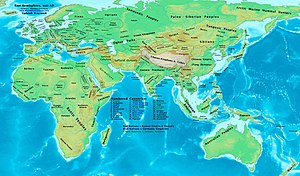
Back 10de eeu Afrikaans 10. Jahrhundert ALS 10ኛው ምዕተ ዓመት Amharic Sieglo X AN 10. gēarhundred ANG القرن 10 Arabic القرن العاشر ARZ Sieglu X AST X гӀасру AV 10-eafa decemda AVK
| Millennium |
|---|
| 1st millennium |
| Centuries |
| Timelines |
| State leaders |
| Decades |
| Categories: |
|
Births – Deaths Establishments – Disestablishments |

The 10th century was the period from 901 (represented by the Roman numerals CMI) through 1000 (M) in accordance with the Julian calendar, and the last century of the 1st millennium.
In China, the Song dynasty was established, with most of China reuniting after the fall of the Tang dynasty and the following Five Dynasties and Ten Kingdoms period. The Muslim World experienced a cultural zenith, especially in al-Andalus under the Caliphate of Córdoba and in the Samanid Empire under Ismail Samani. The Abbasid Caliphate continued to exist but with reduced central authority. Additionally, there was a cultural flourishing for the Byzantine Empire, which also reconquered some lost territories, and the First Bulgarian Empire, as well as the Holy Roman Empire during the Ottonian Renaissance. The historian Lynn White mentions of the period that "to the modern eye, it is very nearly the darkest of the Dark Ages ... if it was dark, it was the darkness of the womb".[1] Caesar Baronius famously described it as the Iron Century, because it was 'iron in its harshness and in its sterility of goodness', while Lorenzo Valla gave it the similar name "Age of Lead and Iron".[2]: 2